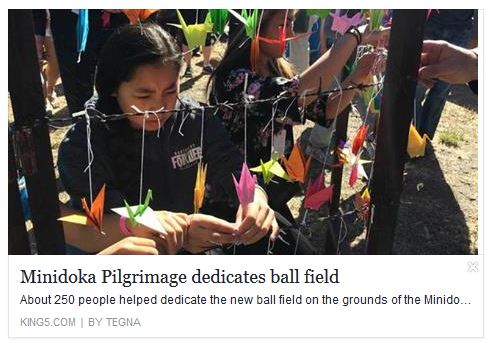
Minidoka
2016 Minidoka Pilgrimage was featured in King 5 News.
Largest Minidoka Pilgrimage Dedicates Ball Field

In 1942, almost 13,000 people of Japanese ancestry, many of whom were American citizens, were removed from their homes and sent to a desolate incarceration "near;camp" Twin Falls, Idaho. Today, most of the 33,000 acres that once made up Minidoka has been taken over by farms. However, in 2001, 73 acres along the North Side Canal, and near the entrance to Minidoka has been designated a National Monument. Minidoka Internment National Monument was established in 2001 as the 385th unit of the National Park System to commemorate the hardships and sacrifices of Japanese Americans interned there during World War II. Also known as the 'Hunt Camp', the Minidoka Relocation Center was a 33,000-acre site with over 600 buildings and a total population of about 13,000 internees held from Washington, Oregon, and Alaska. In 1944, the internees harvested 7,300,000 pounds of produce in the surrounding agricultural fields, making the camp completely self sustainable. It was in operation from August 1942 until October 1945.
Former incarcerees spent nearly 3 years incarcerated at Minidoka and other camps during WWII. Today, the site continues to hold a mixture of memories and strong emotions - feelings of denial, distrust, shame, and joy. The Pilgrimage is attended by former incarcerees, their family members, friends, and allies. The pilgrimage offers an opportunity to revisit the place and the memories amidst family, friends, supporters, and National Park Service officials. The intent is to honor the first generations of Japanese Americans who suffered most under institutionalized racist laws, to deliver the message of “Never Again,” and to pass on the legacy to anyone who will listen.
In a change from previous pilgrimages, the Minidoka Pilgrimage will be conducting its own educational programming on Friday, June 20th at the Red Lion Hotel. For those who wish to attend the Civil Liberties Symposium at the College of Southern Idaho instead on Friday, June 20th,
separate registration is required and must be done through the Symposium directly. The symposium is an opportunity to hear presentations by noted scholars, educators, former Japanese American child incarcerees, and learn about other civil liberty issues.
On Saturday, June 22, participants will have visit the grounds of the National Monument where there will be guided tours of what remains of the former site. Saturday afternoon is our "legacy session" where we break into smaller groups made up of various ages to share stories and experience. On Sunday, a memorial service will be held at the National Monument to honor incarcerees. Participants also have the opportunity to participate in workshops and forums during this time. Throughout the duration of the trip, there will be opportunities to share memories and stories with fellow participants.
